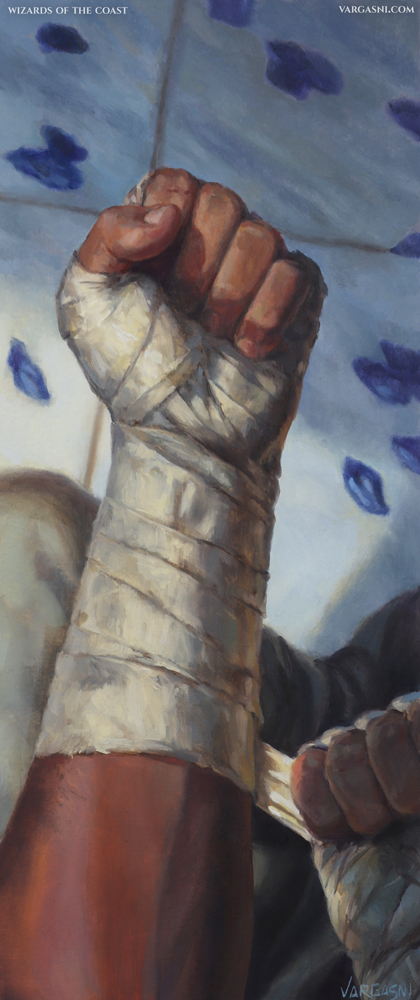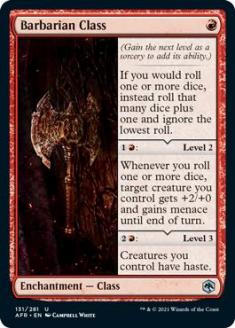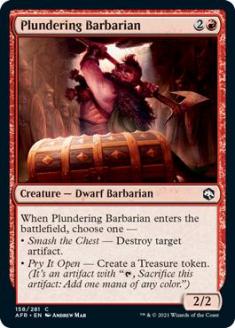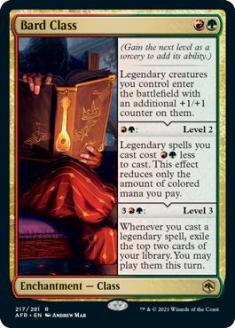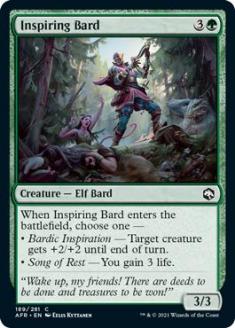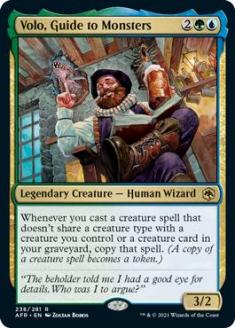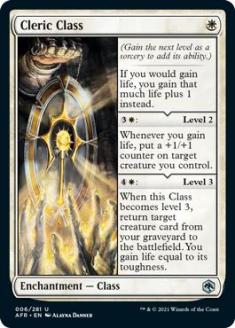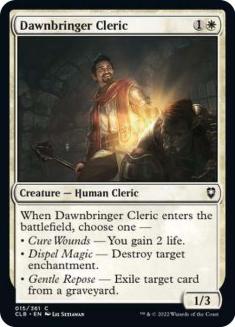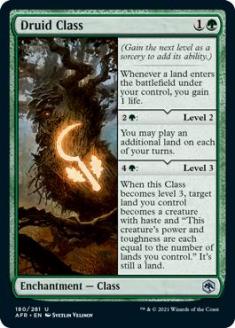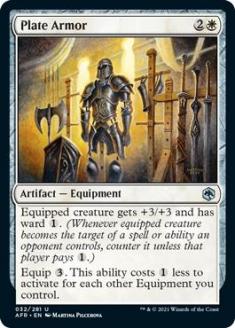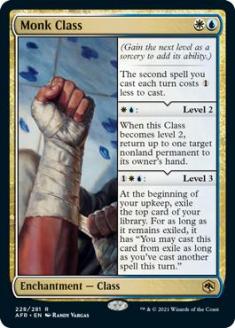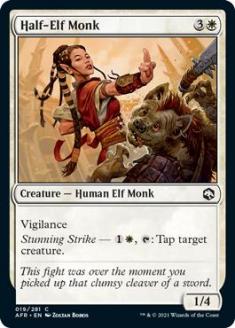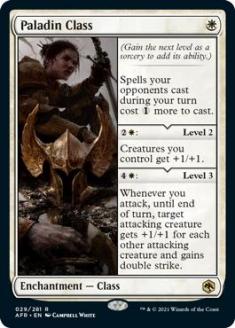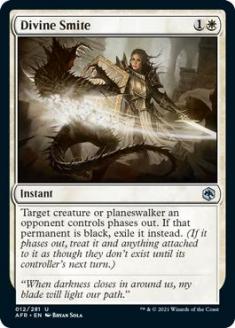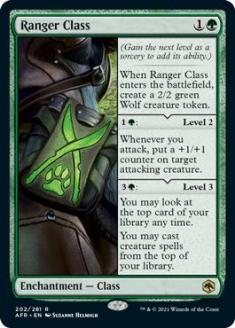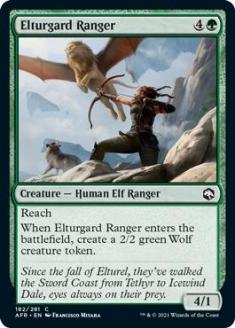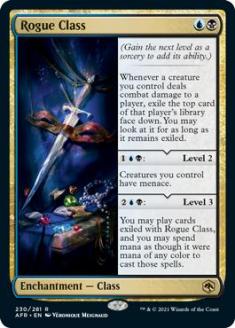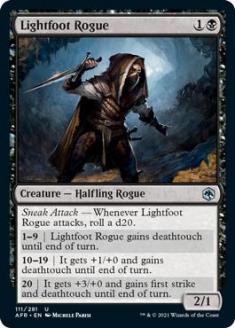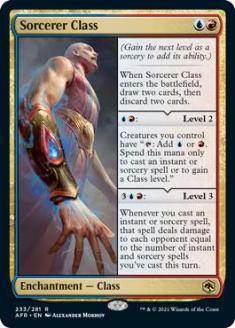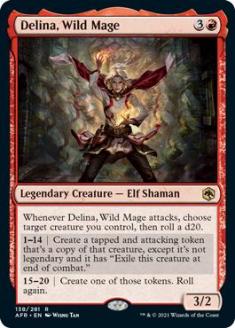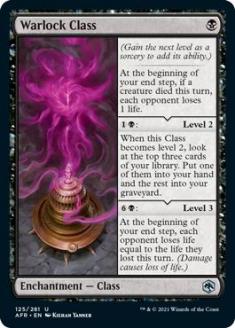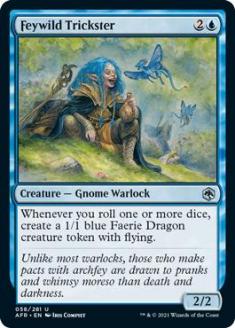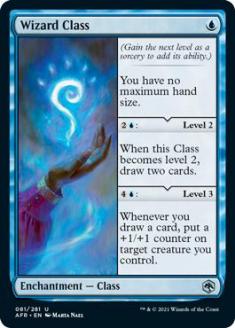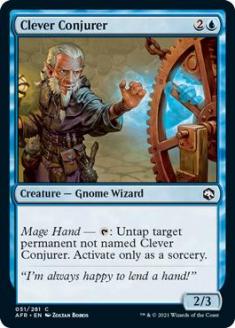Can you hear me, adventurer? You took quite the conk on the head during the final battle with that dragon! Tell me the last thing you remember.
No memory at all? Not even a name? Well that is troubling. Perhaps we could talk about what kind of adventurer you are? Do you cast spells? Wield a sword? Well, if you can’t remember anything, then we had better have a discussion about the classes in Dungeons & Dragons!
Yesterday, we covered the wonderous artifacts in Adventures in the Forgotten Realms including The Deck of Many Things, Wizard’s Spellbook, and more!
Today, we’re talking all about the different classes in Adventures in the Forgotten Realms! Classes are an important part of D&D and each class plays differently. Some classes are powerful spellcasters, while others are masters of the blade, and yet others use no weapon aside from martial arts and spiritual power. Most of the time, each player will play a different class, but there’s nothing stopping multiple players from playing the same class! As the characters level up in their chosen class, they gain stronger abilities, access to more powerful spells, and more. It seems that the design of each of these Class cards has been designed to mimic some aspect or flavor of the class they represent. One of the coolest things I found is that in the art of each of the Class cards the symbol for the class, as found in the Player’s Handbook, can be found and I give full marks for that!
Working the Class symbols into the Art Grade: A+
Barbarian Class
Barbarians are strong, tough heroes who are fueled by unbridled rage! Barbarians eschew the virtues of civilization, instead drawing on the animalistic instincts that flow through them. These heroes are fierce combatants and often fling themselves recklessly into battle with little regard for their own well-being. In combat, barbarians rely on their instincts, prowess, and innate toughness to see them through. They can also fly into a brutal rage, allowing them to strike their enemies with increased fervor and to shrug off brutal attacks that would fell all but the mightiest of heroes!
Let’s cut to the chase before this Barbarian gets angry!
Barbarian Class is a red enchantment — Class that has the following ability:
{1}{R}: Level 2 Whenever you roll one or more dice, target creature you control gets +2/+0 and gains menace until end of turn.
{2}{R}: Level 3 Creatures you control have haste.
As barbarians level up they gain the ability Reckless Attack, an ability that allows them to roll two dice when they roll to attack (instead of one) and pick the higher one; however, in doing so, they sacrifice their defense for the turn. This ability is reflected in the first ability on the card. The second ability represents the additional damage the barbarian deals when they use their rage ability. And I would venture a guess that the final ability represents the barbarian’s increased movement speed it gains by leveling up, allowing it to close the distance in battle. While this card is not overly powerful, it is very flavorful and is a good representation of the class.
Grade: B+
Bard Class
Bards are a versatile class of musical arcane casters. They collect bits of lore along the way and have a tendency to know at least a little tid bit about everything. Many bards avoid direct confrontation, preferring instead to influence the battle by inspiring their allies and impeding their foes. However, many bards have no trouble holding their own in combat if necessary. According to bards, the multiverse was spoken into existence. These words still exist and can be magically woven into song to cast their spells. Bards are naturally charismatic and have a tendency to be the face of the party if not the leader. Their charm, guile, and enchantment spells usually get the party out of (and conversely into) a fair amount of trouble.
Is the Bard Class worthy of the songs of lore? Let’s take a look. Bard Class is a Gruul enchantment with:
{R}{G}: Level 2 Legendary spells you cast cost {R}{G} less to cast. This effect reduces only the amount of colored mana you pay.
{3}{R}{G}: Level 3 Whenever you cast a legendary spell, exile the top two cards of your library. You may play them this turn.
I believe the first ability is referring to the bard’s ability to inspire their allies, called Bardic Inspiration, which they gain at Level 1. At Level 2, bards gain the ability Jack of all Trades which increases their knowledge on every subject by just a small amount. I’m guessing that is what the second ability on the class card is trying to represent. I think that the third ability is the Level 3 ability of the bards known as Expertise in which you become much more proficient in two skills of your choice, but it’s hard to tell. I think Bard Class is a cool card with cool art, but I have some issues with it from a flavor standpoint. Gruul is a surprising choice for a class that relies on guile and eloquence. I would have expected this class to be Simic maybe? Volo is the closest we have to a legendary creature bard and he is a Simic card.
Overall, the abilities of Bard Class are kind of flavorful but require some mental gymnastics to get there.
Grade: C
Cleric Class
Clerics are called to the journey of adventuring by their deities, but they are no mere priest or functionary. Clerics are the divine representatives of their deities in the mortal realm. In fact, they draw their spells from the divine powers of the gods they represent. Clerics themselves are as different as the deities they represent, but they do share some similar abilities. They tend to be the default healing class in D&D, can cast spells to bless their allies, can turn undead, and, at later levels, they can even bring the recent dead back to life. As their connection to their deity increases, so does the potency of their spells.
Let’s shed some light on Cleric Class:
{3}{W}: Level 2 Whenever you gain life, put a +1/+1 counter on target creature you control.
{4}{W}: Level 3 When this Class becomes level 3, return target creature card from your graveyard to the battlefield. You gain life equal to its toughness.
The first ability is clearly a reference to the tendency of the class towards healing. The second ability is likely a reference to the ability of the cleric to buff their party members. And the third ability is a reference of the class to return friends killed in battle to life. The art of the card depicts the cleric using its holy symbol to turn undead by bathing them in holy light. I think this card evokes what makes a cleric a cleric.
Grade: B+
Druid Class
Druids are practitioners of the old ways. They worship and revere nature above all else and work to preserve it in all its glory. They are rewarded for their efforts by being granted powerful spells and abilities from a nature deity or by the primal forces of nature itself. Druids also gain the ability to shapeshift into a wild animal by using an ability called Wild Shape.
Let’s venture into the wild to check out Druid Class, a green enchantment with:
{2}{G}: Level 2 You may play an additional land on each of your turns.
{4}{G}: Level 3 When this Class becomes level 3, target land you control becomes a creature with haste and “This creature’s power and toughness are each equal to the number of lands you control.” It’s still a land.
Druid Class is clearly tied to the land, as one would expect from a class that worships nature, so it also makes sense that it’s green. The first two abilities, while good abilities, aren’t really flavorful outside of being tied to nature. The third ability is also hard to decipher. Is this representing wild shape? The summoning of elementals? The tie druids have to the land? It’s relatively unclear.
I want to like this card but the flavor is not very imaginative for me.
Grade: C-
Fighter Class
Masters of weapons, arms, and armors are fighters. An incredibly diverse class, fighters could range from a bow-wielding sharp shooter to a knight clad in plate mail to a dextrous rapier-wielding swashbuckler. They’re most comfortable on the field of battle. What really makes a fighter isn’t just their equipment, it’s how they use it. Fighters train with a variety of weapons to the point of proficiency and are comfortable in every type of armor. While it is by no means a necessity, I will say that it is incredibly satisfying when, as a fighter, you can slap down the gold and pay for your first set of plate armor.
So how does the card for Fighter Class measure up? Let’s test its mettle! Fighter Class is a Boros enchantment with:
{1}{R}{W}: Level 2 Equip abilities you activate cost {2} less to activate.
{3}{R}{W}: Level 3 Whenever a creature you control attacks, up to one target creature blocks it this combat if able.
Boros feels like the perfect fit for a fighter. The enchantment is also Equipment-centric just like the class is in D&D. The first ability allows you to go find your Equipment (you can even go get your Plate Armor!). The card then allows you to arm for battle sooner with its second ability. My only gripe is its third ability, which I guess is representing the fighter rushing into combat and strategically attacking a foe who is trying to avoid combat. It is a little weak.
Other than that, I feel like this card is pretty flavorful.
Grade: B
Monk Class
Monks are the martial artists of D&D. Monks gain supernatural abilities by harnessing a mystical spiritual energy called ki. Monks are able to move quickly across the battlefield. By channeling their ki, monks can unleash a Flurry of Blows against their opponents, allowing them to attack in rapid succession. They rely on their instincts and their natural dexterity to keep them safe in combat. As monks level up, these dexterous fighters are able to manipulate the ki in their opponents, allowing the monk to stun opponents foolish enough to challenge them.
I’m stunned with how much I like this card! Monk Class is an Azorius enchantment with:
{W}{U}: Level 2 When this Class becomes level 2, return up to one target nonland permanent to its owner’s hand.
{1}{W}{U}: Level 3 At the beginning of your upkeep, exile the top card of your library. For as long as it remains exiled, it has “You may cast this card from exile as long as you’ve cast another spell this turn.”
I really like that Monk Class is Azorius. The concept of a nimble enlightened warrior monk just feels very blue and white. The first and third abilities are clearly trying to emulate Flurry of Blows, which is the monk’s signature ability. The second ability is trying to emulate the Stunning Strike ability which is another ability monks are well known for.
Overall, I really like this card and feel it is very flavorful.
Grade: A
Paladin Class
This is one of my favorite classes in D&D. Paladins are holy warriors who have taken oaths to uphold justice and righteousness and to stand as a beacon of light against the forces of darkness and evil. Paladins train with martial weapons and with armor, but are also able to heal the suffering of others using their Lay on Hands ability. Able to cast a small number of spells, Paladins are a hybrid between fighters and clerics. A paladin exudes righteousness and, at later levels, they gain powerful auras that help protect their party members. However, their signature ability is Divine Smite which allows them to deal massive damage to all those who would cause harm to the innocent.
Onward! Let’s check out Paladin Class! Paladin Class is a white enchantment with:
{2}{W}: Level 2 Creatures you control get +1/+1.
{4}{W}: Level 3 Whenever you attack, until end of turn, target attacking creature gets +1/+1 for each other attacking creature and gains double strike.
The first ability is presumably the protective aura I mentioned earlier. The second ability does offer a buff which paladins can do; however, in my opinion, this isn’t super flavorful. The third ability likely represents the paladin charging into battle along with the rest of the party and using its divine smite on its opponent. The ability is kind of flavorful.
Paladin Class has some powerful abilities, but the flavor is mediocre at best.
Grade: C
Ranger Class
Rangers are fearsome hunters that specialize in keeping civilization safe from the monsters that lurk just beyond its borders. Rangers are usually found in the outskirts, where the frontiers of civilization meet with the untamed wild of nature. Rangers are often guides, trappers, trackers, or scouts when they’re not adventuring. Much like the paladin, rangers are a hybrid class between druid and fighter. As such, they’re able to cast a limited number of spells. Whether with the blade or with a bow and arrow, rangers are skilled hunters with the ability to stalk and kill prey thanks to their keen instincts. Through experience or study, rangers develop favored enemies. But life on the hunt is often lonely, which is why many rangers are accompanied by an animal companion.
Let’s track down and see what we can find out about the card! Ranger Class is a green enchantment with:
{1}{G}: Level 2 Whenever you attack, put a +1/+1 counter on target attacking creature.
{3}{G}: Level 3 You may look at the top card of your library any time. You may cast creature spells from the top of your library.
The first ability is an obvious nod to the animal companion that the class earns early on. The second ability is a reference to the ranger when fighting against your favored enemy, your opponent! The third ability is a clear nod to the ranger’s spellcasting ability. One of the spells rangers eventually get access to is Conjure Woodland Beings which allows them to summon several wild creatures.
I think this is the first card since Barbarian Class that has nailed the flavor on all three abilities! This card is a critical hit for me!
Grade: A
Rogue Class
Stealth and subterfuge are the name of the game for rogues. Rogues are notoriously good at getting into places where they’re not supposed to be. They are adept at disarming traps, picking locks, and liberating treasure from unsuspecting monsters. They also develop expertise in the skills they use often. When it comes to combat, rogues are slippery and evasive. They prefer to attack from the shadows or some other advantageous position where they can make use of their deadly sneak attack ability.
Let’s sneak on over and take a peak at Rogue Class! This Dimir enchantment has the following abilities:
{1}{U}{B}: Level 2 Creatures you control have menace.
{2}{U}{B}: Level 3 You may play cards exiled with Rogue Class, and you may spend mana as though it were mana of any color to cast those spells.
The first ability allows you to pick your opponent’s pockets. . .err library. The second ability allows your creatures to be even better at thieving and the third ability allows you to use your opponent’s cards newly acquired cards!
The flavor of this card is pretty cute I will admit. It doesn’t have much to do with the class abilities, but stealing stuff and making use of it is pretty much the rogue’s whole bag! Check your pockets as we move on to the next class!
Grade: A
Sorcerer Class
Some spellcasters spend years of careful study to master the arcane arts. Others pay terrible prices and enter into pacts with other worldly beings for access to such power. For the sorcerer, magic is in their blood, their very being. The source of this power could come from a draconic ancestor, interacting with a powerful item or substance, a touch of the divine, or simply have no reasonable explanation. This power manifests in the ability of the sorcerer to cast and shape powerful spells in ways that other arcane spellcasters could only dream of. There are two main types of origins in the D&D Player’s Handbook 5e: Draconic Bloodline and Wild Magic. Wild Magic emanates from Raw Chaos Magic which can surge and manifest in strange ways as is the case with Delina, Wild Mage.
Shall we conjure up the card? Sorcerer Class is an Izzet enchantment with the following ability:
When Sorcerer Class enters the battlefield, draw two cards, then discard two cards.
{U}{R}: Level 2 Creatures you control have “{T}: Add {U} or {R}. Spend this mana only to cast an instant or sorcery spell or to gain a Class level.
{3}{U}{R}: Level 3 Whenever you cast an instant or sorcery spell, that spell deals damage to each opponent equal to the number of instant and sorcery spells you’ve cast this turn.[/quote]
Sorcerers have a reputation for being spell-slingers in D&D so Izzet makes perfect sense here. They can also exchange spell points (the resource they use to alter their spells) to recover spell slots which is reflected in the first ability. The second ability encourages you to get to spell-slinging and the third ability rewards you for slinging multiple spells each turn.
Overall, the most flavorful ability is probably the first one. The card is good and definitely does what Izzet does and encourages the kind of spell-slinging I would expect from a sorcerer.
Grade: B
Warlock Class
Warlocks are arcane spellcasters who have entered into pacts with powerful otherworldly beings. These beings can be malevolent, benevolent, somewhere in between, or unknowable. Unlike wizards and sorcerers, warlocks have fewer spell slots, but can recover them more quickly. Their signature spell is Eldritch Blast, which blasts their enemies with otherworldly force. Once chosen, the warlock is beholden to the patron and may be required to perform various tasks or undertake various quests at their behest. This can include entering into a life of adventure. While some warlock patrons are fiendish in nature and request that their patronee perform evil acts, not all patrons are evil, such as pacts made with archfey who may instead instruct the warlock to perform small pranks and minor chaos.
Let’s see what we can glean from the card. Warlock Class is a black enchantment with:
{1}{B}: Level 2 When this Class becomes level 2, look at the top three cards of your library. Put one of them into your hand and the rest into your graveyard.
{6}{B}: Level 3 At the beginning of your end step, each opponent loses life equal to the life they lost this turn. (Damage causes loss of life.)
So the only flavorful ability here is maybe the middle one? I’m having trouble seeing the flavor here. If this card was more similar to Phyrexian Arena where you are paying life for cards or life for tutor effect that would make more sense to me.
While Warlock Class is neat, it doesn’t really fit the flavor. I would pass on this pact.
Grade: D
Wizard Class
Unlike other spellcasters (such as sorcerers or warlocks), wizards gain their spells from rigorous study and experimentation. They are the masters of the arcane arts and master of spells. Wizards also choose a school within which they specialize such as divination, enchantment, illusion, transmutation, or even necromancy.
Wizard is my favorite class to play in D&D. This is due to the Wizard’s Spellbook which I covered in my last article yesterday. To me, the flexibility of this class has enormous appeal. No other class has the range or availability of spells like a wizard. I have played many wizards in my tenure as a D&D player and none of them have felt the same. I have a few favorite spells I usually take for sure, but overall, the class is, in my opinion, one of the most versatile spellcasters in the game. And I almost always take the spell Mage Hand and you should too! Don’t touch stuff, it could be trapped!
Now then, let’s divine what we can on the Wizard Class card. Wizard Class is a blue enchantment with:
{2}{U}: Level 2 When this Class becomes level 2, draw two cards.
{4}{U}: Level 3 Whenever you draw a card, put a +1/+1 counter on target creature you control.
The first ability is definitely a reference to the Wizard’s famed spell book and we have other sources within Magic: The Gathering that offer the same effect, such as including the card Spellbook which the wizard gains at Level 1. The second ability is a reference to Arcane Recovery, an ability that allows the wizard to regain spell slots during a short rest. This is also very flavorful. The last ability rewards you for continuing your arcane studies by allowing you to pump a creature with +1/+1 counters.
Okay, so the last ability is a bit of a stretch but I am still going to roll with it…
Grade: A- (Completely unbiased)
So there you have it! All twelve basic Dungeons & Dragons class cards! I do hope your head is feeling much better, adventurer. Now that we have gone through all of that, do you remember anything else? Do any of these class cards call to you?
I hope you enjoyed this article. It was truly a labor of love. If you are a Dungeons & Dragons fan like myself and want to read more of my musings about dungeons, dragons, and Game Master advice, check out my blog.
So what did you think of my assessment of the flavor of these cards? What is your favorite Class card from Adventures in the Forgotten Realms?

